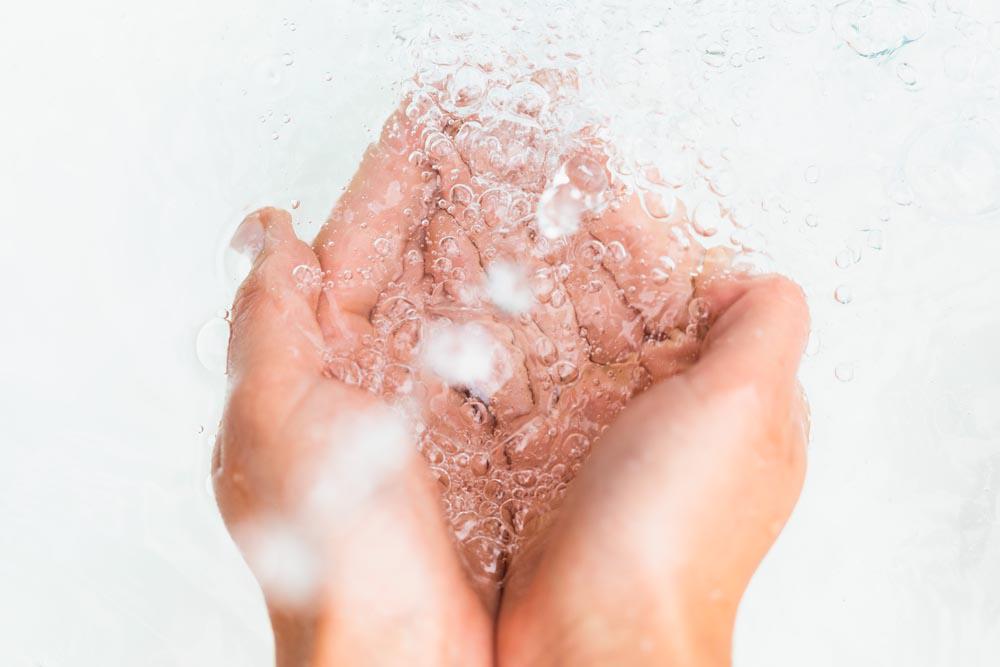The Nine Hallmarks of Aging
Research done in collaboration with many prestigious universities and partners has demonstrated that water produced by Weo’s patented boron-doped diamond electrolysis has properties that help prevent and reverse inflammaging. Let’s take a look at the hallmarks and Weo’s science.
The first hallmark of aging is “Genomic Instability”.
Acting as the blueprint for genetic expression, DNA is responsible for providing all the detailed plans on how every cell in your body should function. The problem is that it is constantly under attack. Free radicals, air pollutants, chemicals, pesticides all expose your DNA to damage. When this damage occurs your cells don’t work as well and this can mean big trouble like cancer.
According to the American Federation of Aging Research, your DNA is damaged one million times per day.
Thankfully, our DNA also encodes instructions on how to repair itself from such insults. But we are limited in how much damage our DNA can take - this repair can only go so far. As we age the damage to your DNA piles up and then hits a point where we now have genomic instability.
A component of Weo water has been shown to protect DNA, RNA and proteins the body from attack.
It has also been shown to be a selective antioxidant that only scavenges dangerous free radicals (hydroxyl & peroxynitrite) that have no beneficial biological roles in the body, yet leaves other ROS intact, allowing them to carry out their positive functions.
©Weo 2023
The second hallmark of aging is “Telomere Attrition”.
Telomeres are protective caps at the end of each chromosome - a long DNA molecule. Every time your cells undergo cell division, a part of your telomeres is cut o , making them shorter and shorter every time your cell replicates. Eventually, your telomeres are so short or no longer existent that your cells are unable to divide. This accelerates the aging process.
Due to the finite nature of telomere length, researchers looked into their correlation to determine lifespan. A research article published in the Proceedings of the National Academy of Sciences investigated telomere length in various species.
The article concludes, “The results shown here indicate that the telomere shortening rate of a species can be used to predict the life span of that species…” It is important for cells to divide so that old or damaged cells can be replaced. Hypothesis that more insults that cause damage to cells may cause them to divide more - thus decreasing telomere length.
A recent human clinical trial demonstrated that consuming water enriched with a potent biomolecule contained in Weo water was able to statistically increase telomere length and increase a known marker of DNA methylation (Tet methylcytosine dioxygenase 2, TET2) expression.

©Weo 2023
The third hallmark of aging is referred to as, “Epigenetic Alterations”.
Aside from red blood cells and cornified cells, every cell in your body has DNA; the same DNA. But how is it that a liver cell functions di erently from a skin cell? The answer lies in which genes (found in your DNA) are expressed. This is called your epigenome. An epigenome is a multitude of chemical compounds that provide instructions for your DNA, telling them what to do & make (express).
DNA is the blueprint of your body. Your epigenome is the contractor. The field of epigenetics studies how your behaviors, habits and environment can change the way your genes work. For example, stress levels, diet and environmental toxins can impact the epigenome.
These epigenetic alterations such as deletions, mutations and translocations can cause genomic instability. Being dehydrated puts extra stress on the epigenome as does a bad diet, poor sleep, being overweight and consuming too much alcohol or smoking.

A component of Weo water has been shown in a human clinical trial to help with body composition - total, visceral, and subcutaneous fat mass showed a more significant decrease over time compared to a control group consuming regular water.
©Weo 2023
The fourth hallmark of aging is “Loss of Proteostasis”.
The word “proteostasis” means being able to maintain a stable production of proteins in your body. A loss of proteostasis happens when our protein-building machinery doesn’t function properly and this can mean big trouble because proteins are precious molecules in the human body.
They have essential functions such as being enzymes that drive all the major biochemical reactions.
During times where oxidative stress (inflammation, an imbalance between your free radicals and antioxidants in your body, problems with proteins can occur more frequently. Such as balance is important in every aspect of life, there too must be a balance in protein production and protein degradation.
A critical tipping point in regards to our health and the process of aging occurs when replenishing good proteins no longer keeps up with depletion of the damaged ones

In a recent study, a bioactive molecule produced by Weo’s technology has been shown In studies to have mitochondrial activity via elimination of misfolded proteins and mtUPR-mediated rejuvenation of compromised mitochondria.
This function adds to the protection of proteostasis in the body - thereby helping with a process of aging.
©Weo 2023
The fifth hallmark of aging, “Deregulated Nutrient Sensing” has to do with your cells’ sensors that respond to changes in nutrient levels in your body. In general, cells have to be careful with how much nutrient is let in.
This is because the process of turning your food into energy, called metabolism, is a double-edged sword. Every time your body turns food into energy, your body creates damaging free radicals. Your cells’ nutrient sensors are there to make sure this is in balance but over time your cells accumulate damage from oxidative stress. This can cause issues with these sensors. This is where glucose regulation comes in.
Over time, our cells can become insulin-resistant - leading to pre-diabetes (1 in 3 people in the US have this & 80% don't even know it!) or end-stage diabetes. This can lead to metabolic syndrome, where we are now at a huge risk for cardiovascular diseases and even cancer. Sadly, the standard American diet leads to this glucose issue. Studies have shown that caloric restriction can have a profound impact on aging research but who wants to limit their calories to almost nothing to get this e ect?!
A simpler strategy is to use the hydration that you already need to get your cell sensors less stressed. Studies have shown a component in Weo water can help with this issue - they found “treatment significantly reduced body fat percentage, and arm fat index, compared to placebo administration, respectively. This was accompanied by a significant drop in serum triglycerides compared to placebo. Fasting serum insulin levels dropped by 5.4% after administration.
Another review article showed that it “may prevent inflammation and regulate the nutrient-sensing mTOR system, autophagy, apoptosis, and mitochondria, which are all factors related to aging.”
©Weo 2023
Mitochondrial Dysfunction is another hallmark of aging.
Several positive e ects of Weo water on our mitochondria have already been highlighted above. Also, there is a strong hypothesis that hydration may improve mitochondrial function because as cells get more and more dehydrated, the metabolism of free fatty acids & amino acids to pyruvate and/or acetyl-CoA decreases producing a dependence on glucose as the main fuel source [as has been reported for obesity. Furthermore, as the cell decreases in size, the ability of insulin to stimulate glucose uptake decreases, leading to insulin resistance. i.e.
Your cells may work better in general when they are well-hydrated.
Cellular Senescence.
At Weo, we are deeply invested in partnership with the Buck Institute for Research on Aging in exploring our e ects on one of the most important hallmarks of aging, Cellular Senescence. Senescence is a normal process of aging; the number of senescent cells increases in our bodies with age.
Cellular senescence is a natural protective mechanism that prevents damaged cells from proliferating further. But senescence has a dark side.
It has a causative role in deleterious conditions associated with aging because senescent cells secrete molecules called Senescence-Associated Secretory Phenotype (SASP) factors. These SASP factors are very inflammatory.
Excitingly, preliminary studies at Weo are showing a promising e ect (ex vivo) of our water on the remediation of this issue. Stay tuned for more info!
©Weo 2023
The last two hallmarks of aging are “Stem Cell Exhaustion” and “Altered Intercellular Communication”.
These both tie into inflammation and cellular senescence. Here’s why: Stem cells are undi erentiated cells, just waiting for the signal to become a cell that the body needs for proper function. As stem cells they don’t yet have a specialized job yet but are ready to go when called upon. As we age, as one would expect, our stem cell pool (which is not infinite) is called upon to act but eventually, the pool runs out and our body su ers. Damage to our DNA is a reason that our stem cells get used up to and as you read a component of Weo water helps with protection! This is because high ROS levels due to stress and inflammation may cause stem cell exhaustion, induce stem cell di erentiation, and enhance motility.
Altered Intercellular Communication is just what it sounds like - cells have trouble talking to each other, which involves changes in endocrine, neuroendocrine, or neuronal function. Some examples of neurohormonal signaling include renin-angiotensin, adrenergic, insulin-IGF1 signaling. Stated in plain terms - hydration homeostasis, adrenal function and blood sugar regulation, respectively. These all tend to become deregulated in aging. And as inflammatory reactions increase, immunosurveillance against pathogens and premalignant cells declines - putting at risk for infections and cancer. A prominent aging-associated alteration in intercellular communication is actually called “inflammaging”. This proinflammatory phenotype that accompanies aging may result from multiple causes, as we have covered. These alterations in communication can also result in an increased activation of the proinflammatory pathways. And we know Inflammation is also involved in the process of obesity, type 2 diabetes, and - conditions that contribute to and correlate with aging in the human population.
A solid strategy that may combat this process of altered cell communication is to employ the use of selective antioxidants that fight oxidative stress, like Weo water!
©Weo 2023
The greatest conundrum of life is that we all want to grow old but no one wants to experience all the woes getting older brings with it. This is one of the reasons the field of anti-aging and inflammaging has become one of the hottest topics of discussion, social media posts, and scientific research.
From beauty companies and health foods to pharmaceutical and supplement development, all are striving to bring promises of “anti-aging” to your hands.
Now that we covered the actual mechanisms for aging, the nine hallmarks, you may have a better idea of what to do, especially what to drink! Cheers to Weo water and all that it can do to prevent and reverse inflammaging!
Dr. Kelly Halderman
Weo’s Chief Health O cer
©Weo 2023 we-o.com
Thank you
References:
▪ López-Otín C, Blasco MA, Partridge L, Serrano M, Kroemer G. The hallmarks of aging. Cell. 2013 Jun 6;153⑥:1194-217. doi: 10.1016/j.cell.2013.05.039. PMID: 23746838; PMCID: PMC3836174.
▪ Zanini D, Todorovic N, Korovljev D, Stajer V, Ostojic J, Purac J, Kojic D, Vukasinovic E, Djordjievski S, Sopic M, Guzonjic A, Ninic A, Erceg S, Ostojic SM. The e ects of 6-month hydrogen-rich water intake on molecular and phenotypic biomarkers of aging in older adults aged 70 years and over: A randomized controlled pilot trial. Exp Gerontol. 2021 Nov;155:111574. doi: 10.1016/j.exger.2021.111574. Epub 2021 Oct 1. PMID: 34601077.
▪ Pre-publishing phase of Cellular Senescence data - Buck Institute for Research on Aging
▪ The e ects of Weo Water on Lifespan in a C. elegans model for longevity. May 2019University of Miami - Aging - C. Elegans - USA (unpublished).
▪ Ohsawa I, Ishikawa M, Takahashi K, Watanabe M, Nishimaki K, Yamagata K, Katsura K, Katayama Y, Asoh S, Ohta S. Hydrogen acts as a therapeutic antioxidant by selectively reducing cytotoxic oxygen radicals. Nat Med. 2007 Jun;13⑥:688-94. doi: 10.1038/nm1577. Epub 2007 May 7. PMID: 17486089.
▪ Sobue S., Inoue C., Hori F., Qiao S., Murate T., Ichihara M. Molecular hydrogen modulates gene expression via histone modification and induces the mitochondrial unfolded protein response. Biochem. Biophys. Res. Commun. 2017;493:318–324. doi: 10.1016/j.bbrc.2017.09.024.
▪ Lee, M.Y., Kim, Y.K., Ryoo, K.K. et al. Electrolyzed-reduced water protects against oxidative damage to DNA, RNA, and protein. Appl Biochem Biotechnol 135, 133–144 (2006). https://doi.org/10.1385/ABAB:135:2:133
▪ Kirkland JL, Tchkonia T. Senolytic drugs: from discovery to translation. J Intern Med. 2020 Nov;288⑤:518-36.
▪ Wissler Gerdes EO, Zhu Y, Tchkonia T, et al. Discovery, development, and future application of senolytics: theories and predictions. FEBS J. 2020 Jun;287(12):2418-27.
▪ Calcinotto A, Kohli J, Zagato E, et al. Cellular Senescence: Aging, Cancer, and Injury. Physiol Rev. 2019 Apr 1;99②:1047-78.
▪ Childs BG, Li H, van Deursen JM. Senescent cells: a therapeutic target for cardiovascular disease. J Clin Invest. 2018 Apr 2;128④:1217-28.
▪ Childs BG, Durik M, Baker DJ, et al. Cellular senescence in aging and age-related disease: from mechanisms to therapy. Nat Med. 2015 Dec;21(12):1424-35.
▪ Herranz N, Gil J. Mechanisms and functions of cellular senescence. J Clin Invest. 2018 Apr 2;128④:1238-46.
▪ https:// .techexplorist.com/senescent-cells-help-heal-damaged-tissues/54283/
▪ Korovljev D, Trivic T, Drid P, Ostojic SM. Molecular hydrogen a ects body composition, metabolic profiles, and mitochondrial function in middle-aged overweight women. Ir J Med Sci. 2018 Feb;187①:85-89. doi: 10.1007/s11845-017-1638-4. Epub 2017 May 30. PMID: 28560519
▪ Zhiling Fu, Jin Zhang, Yan Zhang, "Role of Molecular Hydrogen in Ageing and Ageing-Related Diseases", Oxidative Medicine and Cellular Longevity, vol. 2022, Article ID 2249749, 17 pages, 2022. https://doi.org/10.1155/2022/2249749
▪ Rogge MM. The role of impaired mitochondrial lipid oxidation in obesity. Biol Res Nurs (2009) 10:356–73. doi:10.1177/1099800408329408
©Weo 2023




